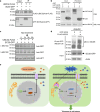SC35-mediated bZIP49 splicing regulates K⁺ channel AKT1 for salt stress adaptation in poplar
- PMID: 40769973
- PMCID: PMC12328635
- DOI: 10.1038/s41467-025-62448-9
SC35-mediated bZIP49 splicing regulates K⁺ channel AKT1 for salt stress adaptation in poplar
Abstract
Soil salinization threatens plant distribution, crop yields, and ecosystem stability. In response, plants activate potassium (K+) signaling to maintain Na⁺/K⁺ balance, though the mechanisms regulating K⁺ uptake under salt stress remain poorly understood. This study identified two splice variants of the bZIP49 transcription factor in Populus tomentosa: unspliced "bZIP49L" and spliced "bZIP49S". bZIP49S, the active form under salt stress, reduces salt tolerance when overexpressed, while bzip49cr knockout enhances it. The serine/arginine-rich splicing factor SC35 was identified as a regulator of bZIP49 mRNA splicing through a self-developed experimental method, and its overexpression enhances salt sensitivity. bZIP49S inhibits the K+ transporter AKT1 by binding its promoter, and AKT1 loss in bzip49cr mutant limits K+ influx and reduces salt tolerance. Under salt stress, the E2 ubiquitin-conjugating enzyme UBC32 promotes SC35 degradation via ubiquitination, lowering bZIP49S levels and alleviating the inhibition of AKT1. This facilitates K⁺ uptake, restores Na⁺/K⁺ balance, and improves salt tolerance. Our study highlights the critical role of bZIP49 splicing and the "UBC32-SC35-bZIP49-AKT1" module in modulating Na⁺/K⁺ balance under salt stress in poplar.
© 2025. The Author(s).
Conflict of interest statement
Competing interests: The authors declare no competing interests. Ethical approval: This study did not involve human participants, animal subjects, or sensitive social data. All authors contributed equally, regardless of gender, nationality, or institutional affiliation. The research was conducted in compliance with institutional guidelines for responsible and ethical scientific practices.
Figures






Similar articles
-
Physiological and transcriptomic analyses reveal the molecular mechanism of PsAMT1.2 in salt tolerance.Tree Physiol. 2024 Oct 3;44(10):tpae113. doi: 10.1093/treephys/tpae113. Tree Physiol. 2024. PMID: 39231271
-
Rice RING E3 Ligase OsRFP45 Negatively Regulates Salt Tolerance by Modulating Na+/K+ Transporter Genes.Physiol Plant. 2025 May-Jun;177(3):e70327. doi: 10.1111/ppl.70327. Physiol Plant. 2025. PMID: 40546069 Free PMC article.
-
The interaction complexes of TsHKT1 splicing variants enhance salt tolerance of Thellungiella salsuginea by decreasing Na+ uptake.Plant Sci. 2025 Oct;359:112678. doi: 10.1016/j.plantsci.2025.112678. Epub 2025 Jul 23. Plant Sci. 2025. PMID: 40712791
-
Identification of crucial genes sustaining the curled leaf phenotype in perennial transgenic poplar via advanced proteomic and phosphoproteomic analyses.J Proteomics. 2025 Aug 15;319:105471. doi: 10.1016/j.jprot.2025.105471. Epub 2025 Jun 3. J Proteomics. 2025. PMID: 40472892 Review.
-
Salt stress-responsive transcription factors provide insights to enhance barley improvement: a review.Planta. 2025 Jul 16;262(3):56. doi: 10.1007/s00425-025-04760-8. Planta. 2025. PMID: 40670803 Review.
References
-
- Yang, Y. & Guo, Y. Elucidating the molecular mechanisms mediating plant salt-stress responses. N. Phytol.217, 523–539 (2017). - PubMed
-
- Zhu, J. K. Plant salt tolerance. Trends Plant Sci.6, 66–71 (2001). - PubMed
-
- Munns, R. Genes and salt tolerance: bringing them together. N. Phytol.167, 645–663 (2005). - PubMed
-
- Jiang, Z. et al. Plant cell-surface GIPC sphingolipids sense salt to trigger Ca2+ influx. Nature572, 341–346 (2019). - PubMed
MeSH terms
Substances
Grants and funding
LinkOut - more resources
Full Text Sources
Miscellaneous

